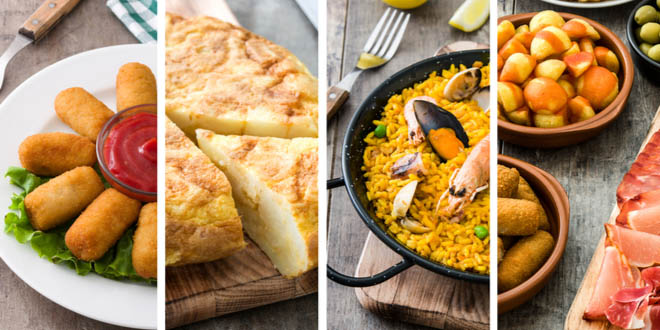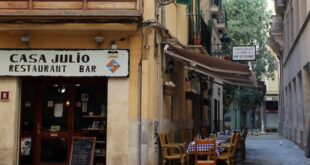Last Updated on March 13, 2023
Spain is made up of many different regions. And, as in many other countries, each of which has their own distinctive flavor and cuisine. I discovered the many delicious offerings of the Iberian Peninsula while traveling in Spain one summer. Moreover, I was quick to attempt the replication of many of the dishes I will mention as soon as I returned home. So I made sure I brought with me the best extra virgin olive oil Picual. While many different foods that are considered to be Spanish have originated in specific regions of the country, the foods I mention below were some of my favorite. Whether you are planning a trip to Spain, or a trip to your local Spanish restaurant, you absolutely must try some of these.
Paella
Paella is traditionally a dish that is cooked in large quantities over an open fire outdoors, often for celebrations or gatherings. This dish has existed in the Iberian Peninsula in one form or another since around the 10th century and utilizes the short-grained Bomba rice. Some of the original traditional ingredients that were often used in paella are rabbit, snails, and beans. Today there are many more variations of paella. For example: vegetable paella, seafood paella or chicken paella. Aside from the rice, the one ingredient that remains necessary is the saffron, which gives the dish its characteristic yellow hue.
Valencia is considered to be the native home to the dish. A traditional Valencian paella would include a combination of the following ingredients: chicken, rabbit, snails, duck, great northern beans, artichoke, runner beans, and tomatoes. Throughout Spain, however, mixed paella (combining seafood with meat from land animals) is becoming more and more popular.
TAKEAWAY: Two years ago the Valencian company “Arroz La Fallera” launched a campaign so that a paella emoji was created. Unicode told them that, for it to become an emoji, there needed to exist some social demand. Therefore, La Fallera created the hashtag #paellaemoji, and it got to be a global trending topic not once, but twice! After all that noise, Unicode couldn’t deny it anymore, and now Spaniards have their own paella emoji. Way to go! 🥘
Tortilla de Patatas
This dish is one of my personal favorites; it was a staple in my diet when I was traveling in Spain. Spanish tortilla is like an omelet, or a crustless quiche, that is made from eggs and potatoes. It can sometimes also include onions. And when served as a tapa or pintxo, it can have different toppings like ham and cheese, mushrooms, chorizo, peppers, etc.
It is known as Tortilla Española, as a way to distinguish it from the maize or wheat tortilla used in many Central American cuisines. Although, if you are in Spain and see “tortilla” on the menu, this is what they are referring to. For this dish, the potatoes are either thinly sliced or diced into small cubes, seasoned, and then sauteed in olive oil with onions. Then, it is all mixed with beaten eggs.
Gambas al Ajillo
View this post on Instagram
This popular shrimp dish is found more in the southern and central parts of Spain, especially in Andalusia. The reason for this is that, in the coastal regions of that area, they fish high-quality red shrimps. In its purest form, gambas al ajillo consists of shrimp, garlic, and olive oil, but there are many variations. This dish is typically ordered as an appetizer, but due to its popularity, you can often get it as an entree. You might also see it with parsley and chili peppers for a spicier version.
Queso Manchego
Manchego is a delicious cheese made from sheep’s milk in La Mancha region of Spain. This cheese can be aged anywhere from 60 days all the way to 3 years, and the price will vary accordingly. The flavor of the cheese is fairly mild with a slight briny nuttiness and rather dry, which makes it a perfect compliment to a more fruity Spanish wine!
You can tell a traditional Manchego from the zigzag cross hatch pattern on the rind that is formed by the original presses. Manchego is everywhere in the markets in Spain and is often served as an appetizer all by itself, or sometimes with Andalusian olives in olive oil with garlic and lemon. Manchego is usually cut in thin triangular shaped pieces, as it would be cut from the wedge right from the whole wheel of cheese.
Lomo Ibérico
This delicious dry-cured pork loin is a great compliment to the previously mentioned Manchego. The pork is usually seasoned with paprika, a staple in many Spanish dishes, and then cured for about three months. It emerges a deliciously marbled sausage that has smoky aromas and flavors. Lomo Ibérico is served at room temperature and thinly sliced. Although, sometimes, the lomo can be presented in a “tabla” (a wooden board) accompanied by jamón ibérico, chorizo, and salchichón. The top 4 of Spanish Iberian cured meats.
Pimientos de Padrón
These are small peppers of varying shades of green that hail from the area of Padron (north-western Spain). They are usually fairly mild. However, one in about ten ends up being quite hot. That’s why Spaniards always say: “Pimientos del Padrón, unos pican y otros no,” which literally means “Padron peppers, some burn, and others don’t.” So that makes them rather fun to eat because you never know when you’ll get a particularly piquant pepper. They are served quite simply; blistered and salted with some olive oil.
Patatas Bravas
Patatas Bravas is absolutely one of my favorite dishes to both order and attempt to make at home. This potato dish is often served at tapas places both in Spain and abroad. The name “bravas” actually means “fierce,” and it comes from the spicy essence of this recipe. White potatoes that have been diced into large bite-sized pieces are fried and tossed in a spicy tomato sauce and often an aioli. Different herbs and spices can be used to give it some variation, particularly paprika.
Arroz Negro
This rice dish receives its deep color from the added squid ink. Some people refer to this dish as ‘squid ink paella’. However, traditionally it is not even called paella, even though the methods of preparation are quite similar. Don’t confuse this with black rice, which is naturally dark in color. Apart from the squid ink and pieces of the squid itself, you will often find other sea creatures such as cuttlefish and increasingly shrimp and crab. And, of course, it will be accompanied by some lemon slices for you to season the rice to your liking.
Nevertheless, if you try this amazing dish, just a little insider’s tip: go check and clean your teeth and lips in the mirror before leaving the restaurant. You wouldn’t want to go all day smiling with black teeth!
These are just a select few of the many fantastic Spanish dishes you can try while traveling in Spain. Even if you have no plans to take a trip anytime soon, search out for a Spanish restaurant or tapas bar and try a few of the foods out. You will not regret it!
 Travel for Food Hub The Food Blog for Travel Lovers
Travel for Food Hub The Food Blog for Travel Lovers

















Great recipe look like so yummy 😋🤤 thanks for sharing this
Amazing
Great recipe look like so yummy 😋🤤 thanks for sharing this